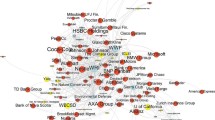Abstract
This paper provides a test of the Appelbaum and Katz (1987) rent-seeking model, in which rents are endogenous. The Appelbaum-Katz model is theoretically modified to correspond to our empirical application, in which rent-seeking and rent-avoiding coalitions are attempting to influence legislators' votes on pesticide regulations. Probit estimations are used to analyze the legislators' votes on two bills to amend pesticide legislation (a proxy for rent). Empirical results generally support the rent-seeking determinants identified in the model. Tobit estimation is used to investigate campaign contributions by the coalitions to the legislators. These contributions are a proxy for rent-seeking activities. Again, the model is supported.
Similar content being viewed by others
References
Abler, D.G. (1991). Campaign contributions and House voting on sugar and dairy legislation.American Journal of Agricultural Economics 73 (February): 11–17.
Almanac of American Politics. (1986). Washington, DC: National Journal.
Amemiya, T. (1984). Tobit models: A survey.Journal of Econometrics 24 (January/February): 3–61.
American Farm Bureau Federation. (1988). Membership data by state.
Appelbaum, E. and Katz, E. (1986). Transfer seeking and avoidance: On the full costs of rent seeking.Public Choice 48(2): 175–181.
Appelbaum, E. and Katz, E. (1987). Seeking rents by setting rents: The political economy of rent seeking.Economic Journal 97 (September): 685–699.
Bosso, C. (1987).Pesticides and politics: The life cycle of a public issue. Pittsburg: University of Pittsburgh Press.
Chappell, H. (1979).The economics of campaign finance: An empirical study. Unpublished doctoral dissertation. Yale University, New Haven, Connecticut.
Chappell, H. (1981). Conflict of interest and congressional voting: A note.Public Choice 37 (2): 331–335.
Chappell, H. (1982). Campaign contributions and congressional voting: A simultaneous probittobit model.Review of Economics and Statistics 64 (February): 77–83.
Congressional Quarterly. (1986).Almanac: 99th Congress, 2nd Session, 1986, Volume 42. Washington, DC: Congressional Quarterly.
Gianessi, L. (1986).A national pesticide usage database. Washington, DC: Resources for the Future.
Hersch, P.L. and MacDougall, G.S. (1988). Voting for “sin” in Kansas.Public Choice 57 (May): 127–139.
Krueger, A.O. (1974). The political economy of the rent-seeking society.American Economic Review 64 (June): 291–303.
MacIntyre, A. (1987). Why pesticides received extensive use in America: A political economy of agricultural pest management to 1970.Natural Resources Journal 27 (Summer): 533–578.
Maddala, G.S. (1983).Limited dependent and qualitative variables in econometrics. Cambridge: Cambridge University Press.
Pindyck, D.S. and Rubinfeld, D.L. (1981).Econometric models and economic forecasts. Second edition. New York: McGraw-Hill.
Posner, R.A. (1975). The social costs of monopoly and regulation.Journal of Political Economy 83 (August): 807–827.
Sierra Club. (1988). Membership data by state.
Tullock, G. (1967). The welfare costs of tariffs; monopolies, and theft.Western Economic Journal 5 (June): 224–232.
Tullock, G. (1980). Efficient rent seeking. In J.M. Buchanan, R.D. Tollison, and G. Tullock (Eds.),Toward a theory of the rent-seeking society, 97–112. College Station: Texas A & M.
U.S. Department of Commerce. (1980).1980 Census of population. Washington, DC: Bureau of the Census.
U.S. Department of Commerce. (1987a).Census of agriculture. Washington, DC: Bureau of the Census.
U.S. Department of Commerce. (1987b).Local area personal income. Washington, DC: Bureau of Economic Analysis.
U.S. Department of Commerce. (1987c).Statistical abstract of the United States. Washington, DC: Bureau of the Census.
U.S. Federal Election Commission. (1985/1986). Campaign contributions data.
Wise, S. and Johnson, S.R. (1991). A comparative analysis of state regulation for use of agricultural chemicals. In R.E. Just and N. Bockstael (Eds.),Commodity and resource policies in agricultural systems, 46–71. Berlin: Springer-Verlag.
Wise, S.J. (1991). Rent-seeking in pesticide policy. Unpublished doctoral dissertation. Iowa State University, Ames, Iowa.
Author information
Authors and Affiliations
Additional information
We have profited from comments provided by an anonymous referee.
Rights and permissions
About this article
Cite this article
Wise, S.J., Sandler, T. Rent-seeking and pesticide legislation. Public Choice 78, 329–350 (1994). https://doi.org/10.1007/BF01047762
Accepted:
Issue Date:
DOI: https://doi.org/10.1007/BF01047762



